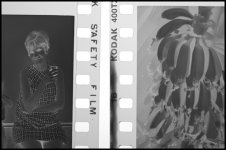Artorius
Caribbean Traveler
I know all about silver halide films. Used film till about 15 yrs ago, when I went all digital. With film like Kodak's BW 400 being dye based, would it be advantageous to use color correction filters, ie; 81A, 85A, even though B&W?
The few rolls of C41 process I've shot and had processed/scanned, I'm not really impressed. New film tech has me nuts.
OR should I just start processing B&W film in the bathroom, not really a problem cause we have 3, and getting a scanner and doing it myself, again.
There are a couple of local labs here that will process and scan, but at about $25.00 for 36 exp. I think I could get a decent scanner, and break out my film processing reels and tank.
Comments and opinions welcomed.
The few rolls of C41 process I've shot and had processed/scanned, I'm not really impressed. New film tech has me nuts.
OR should I just start processing B&W film in the bathroom, not really a problem cause we have 3, and getting a scanner and doing it myself, again.
There are a couple of local labs here that will process and scan, but at about $25.00 for 36 exp. I think I could get a decent scanner, and break out my film processing reels and tank.
Comments and opinions welcomed.





